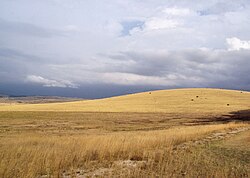Cévennes National Park
| Cévennes National Park | |
|---|---|
| Parc national des Cévennes | |
|
IUCN category V (protected landscape/seascape)
|
|

Florac and of the Cévennes National Park seen from Causse Méjean
|
|
| Coordinates | 44°11′38″N 3°34′53″E / 44.19389°N 3.58139°ECoordinates: 44°11′38″N 3°34′53″E / 44.19389°N 3.58139°E |
| Established | 1970 |
| http://www.cevennes-parcnational.fr/ | |
| The Causses and the Cévennes, Mediterranean agro-pastoral Cultural Landscape | |
|---|---|
| Name as inscribed on the World Heritage List | |

Causse Méjean in Massif Central, Cévennes National Park, France
|
|
| Location | France |
| Type | Cultural |
| Criteria | iii, v |
| Reference | 1153 |
| UNESCO region | Europe and North America |
| Inscription history | |
| Inscription | 2011 (35th Session) |
The Cévennes National Park (French: Parc national des Cévennes) is a national park located in southern France, in the mountainous area of Cévennes.
Created in 1970, the park has its administrative seat in Florac at Florac Castle. It is located mainly in the départements of Lozère and Gard, and covers some parts of Ardèche and Aveyron. The Aven Armand cave is located in the park. In 2011, the Park was made a part of The Causses and the Cévennes, Mediterranean agro-pastoral Cultural Landscape UNESCO World Heritage site.
The park includes several mountains and plateaus, including: Mont Lozère, Mont Aigoual, Causse Méjean, France. Mont Lozère is the highest peak in the area, reaching 1,699 metres.
The Cévennes country is rich of history, with a strong cultural identity, being at the heart of Camisard revolt, which followed the revocation of the Edict of Nantes (the Edict of Fontainebleau), after which Protestants were actively prosecuted. Numerous testimonies of Camisard war in the Cévennes abund in towns and villages of the Cévennes National Park. A permanent exhibition devoted to the memory of Camisards has been elaborated at the old temple of Le Rouve (commune of Saint-André-de-Lancize).
...
Wikipedia

